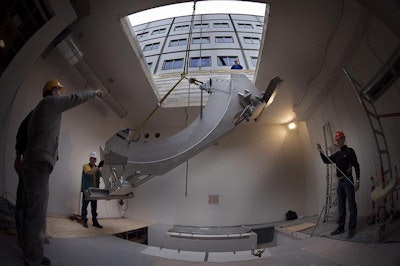
Researchers at the University Medical Center (UMC) in Utrecht, the Netherlands, have begun installation of what is thought to be the world's first high-field MRI-guided radiation therapy system. The clinical realization of this technology may represent the ultimate breakthrough in real-time image guidance: offering soft-tissue-based imaging throughout beam delivery.
As such, UMC staff members have been working for more than a decade to overcome the not-insubstantial technical obstacles required to integrate an MRI system with a linear accelerator. They may finally be about to reap the rewards of their efforts.
Earlier this month, the first component of the world's first high-field MR-guided radiotherapy system was lowered by crane into one of UMC Utrecht's radiotherapy treatment rooms. While the instrument has been extensively tested and proved in an experimental system, this will be the first clinical machine to be built.
 The first component of the linac-MRI -- the system's ring gantry on which linac parts are mounted -- is lowered by crane through a modular roof into one of UMC Utrecht's radiotherapy treatment rooms.
The first component of the linac-MRI -- the system's ring gantry on which linac parts are mounted -- is lowered by crane through a modular roof into one of UMC Utrecht's radiotherapy treatment rooms.Already, 2014 has seen some significant developments in the field of MR-guided radiotherapy. Back in January, the first ever real-time continuous MR imaging during a patient treatment was performed using the ViewRay system. U.S. medical device company ViewRay has taken an alternative approach, in which the linac is replaced by three gamma-emitting cobalt-60 sources, and a weaker 0.35-tesla magnet is employed.
The Utrecht system will be the first linac-based system for MR-guided radiotherapy. Designed in collaboration with Elekta and Philips Healthcare, it comprises a 6 MV accelerator from Elekta rotating on a ring gantry around a modified 1.5-tesla Achieva MRI scanner from Philips.
According to Bas Raaymakers, PhD, associate professor in UMC Utrecht's radiotherapy department, the installation should take around four months to complete, with a working prototype ready by the summer. At this point, it will undergo a program of nonclinical acceptance testing, including dosimetric and mechanical tests, beam alignment, performance evaluation of the MRI sequences, and workflow definition.
"The MRI system has been tested and the linac has been tested. Now the linac and the MRI will see each other for the first time in Utrecht, and we will see how the whole system performs," Raaymakers said.
Once acceptance testing is completed, predicted to be at the end of this year, the researchers plan to perform a series of animal experiments before finally moving on to clinical testing.
Collaborative approach
The development of the high-field MRI-guided linac is being led by the MR Linac Research Consortium, which was set up in 2012 by Elekta, Philips Healthcare, and UMC Utrecht. "Elekta is dedicated to making MR-guidance happen," said Jan Lagendijk, professor of radiation oncology physics at UMC Utrecht.
The consortium has since expanded and now also includes the University of Texas MD Anderson Cancer Center (Houston, Texas), the Netherlands Cancer Institute-Antoni van Leeuwenhoek Hospital (Amsterdam, the Netherlands), Sunnybrook Health Sciences Centre (Toronto) and the Froedtert and Medical College of Wisconsin Cancer Center (Milwaukee, Wisconsin).
"Since formation of the consortium, members have been exploring the feasibility of high-field MR-guided radiotherapy. Installation of the first-generation system is truly a major step toward moving this technology into the clinic to benefit patients," Raaymakers said.
© IOP Publishing Limited. Republished with permission from medicalphysicsweb, a community website covering fundamental research and emerging technologies in medical imaging and radiation therapy.



















